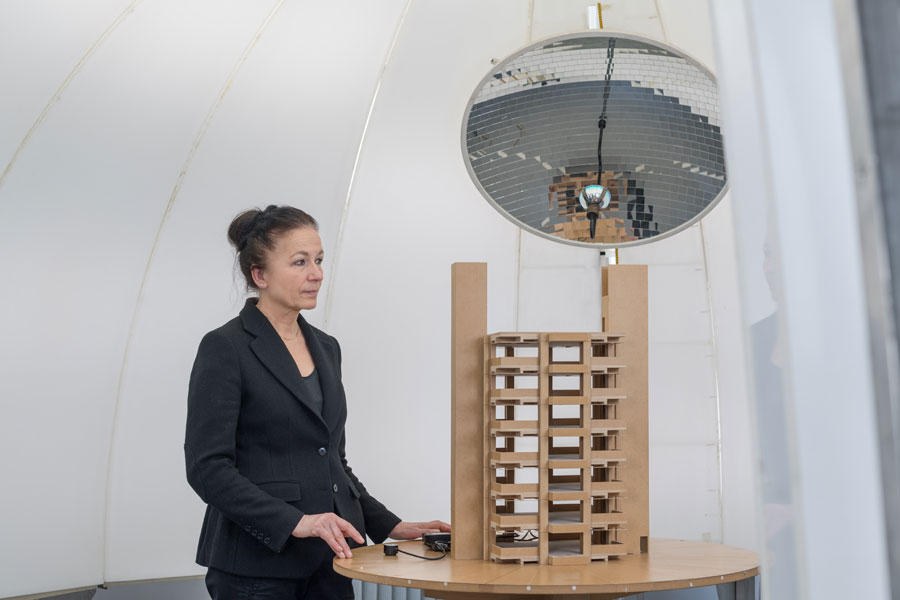Interview with Prof. Hannelore Deubzer, Chair of Spatial Arts and Lighting Design
"The city is becoming a stage and the buildings are screens"

What influence does light have on our perceptions?
Hannelore Deubzer: When you're sitting in a restaurant with a beautiful glass of red wine in front of you, it's the light that makes it look that way. A display in the supermarket has special lighting to make the goods look fresh. It would be naive to think that the meat counter is the only place where they do that. And naturally advertising uses lighting effects, too.
How is light used in architecture?
Deubzer: First and foremost it's all about the effect of daylight – because that's the light that we all need. I can't just put a building somewhere and take other people's light away. There are agreements in society about the necessary clearance for maintaining the quality of a property and the rooms in it. In recent decades, however, artificial light has opened up a further dimension. New types of lamps, especially LEDs, have created enormous possibilities.
What examples do you have in mind?
Deubzer: For example we now have the organic light-emitting diodes. In a dark room you could use this technology to simulate windows and recreate the changing daylight from morning till night. That shows that we are dealing with extremes. Many things are possible. But how do we benefit? Where will it take us? Is it progress? The city is gradually becoming a stage and the buildings are screens. When the Elbphilharmonie concert hall, designed by Herzog & de Meuron, was opened in Hamburg, those insane lights almost turned it into a caricature. It was too much. Today it's often no longer about consciously experiencing something. It's only about the big event.
Where is the distinction?
Deubzer: For me, an event means a brief interruption, a distraction, a way to pass the time. A true experience is the opposite. It's something through which a person can gain insights – a much more demanding, conscious, constructive process. If the two are out of balance, it becomes problematic.
If we look at the Allianzarena stadium in Munich, is that more of an event?
Deubzer: It's a fairground, in a manner of speaking. There's a vast difference between that and the Olympic Stadium, which makes an entirely different statement. The Allianzarena has hardly any visual connection to its location. It's like a big circus where they set up tents, the show takes place, and the ensemble moves on. This atmosphere is palpable. That's why architecture is so exciting: it's an expression of something. The Allianzarena is an astonishing object because it expresses exactly this sense of an entertaining sideshow.
You mentioned the Olympic Stadium as an example of an experience. What's so special about it?
Deubzer: The Olympic Stadium is embedded in a big landscape narrative in this wonderful landscape by Grzimek. The stadium accompanies this expansive breath of the landscape. That's what gives it a connection to the natural light. In the same way as the light moves across this beautiful parkland during the day, it also accompanies this structure, which has an open roof, among other features. That creates a strong impression and is extremely memorable. To convey these splendid impressions – that is the task of architecture.
So when an architect plans something, he should start by thinking about the impression he wants to create and then consider the right kind of light?
Deubzer: Exactly. It's an extremely lengthy process. An artist only has to answer to himself. He can be provocative and do whatever he wants. For us it's different. What we do has to be usable, has to be suitable for use. That's our very first commitment. Another important point is whose building it is, where the initiative is coming from, what's the underlying intention, in what context might people want to use the building for another purpose. This analytic work, which comes at the beginning for every design process, is extremely important because it forms the foundation for the recommendation we make on the spatial implementation of a program. In every sentence I utter, and in every piece of music there is a theme, a rhythm and a structure. It's only when that is present that we can start to think about the construction materials we will use to make a very specific statement. Light is one of the most essential modes of expression. Without light there is no architecture.
Where is Germany's architectural culture headed at the moment?
Deubzer: With the buildings from the 19th century, we had owners whose own biographies were poured into the construction projects. That's different today. In urban planning we mainly have big investors. That leads to a sort of utilitarian architecture. A lot of what we see around us is no longer specific. You can find it anywhere. I think that this has a lot to do with our society. We no longer live within narrow confines. Years ago I would have had no idea why a hotel chain would build the same hotel at every airport. People who travel around the world want to wake up in the same room every day. But that no longer has anything to do with architecture in the true sense of the word.
Highresolultion Images:
Contact:
Prof. Dipl.-Ing. Hannelore Deubzer
Technical University of Munich
Chair of Spatial Arts and Lighting Design
hannelore.deubzer@tum.de
+49 (89) 289 - 22502